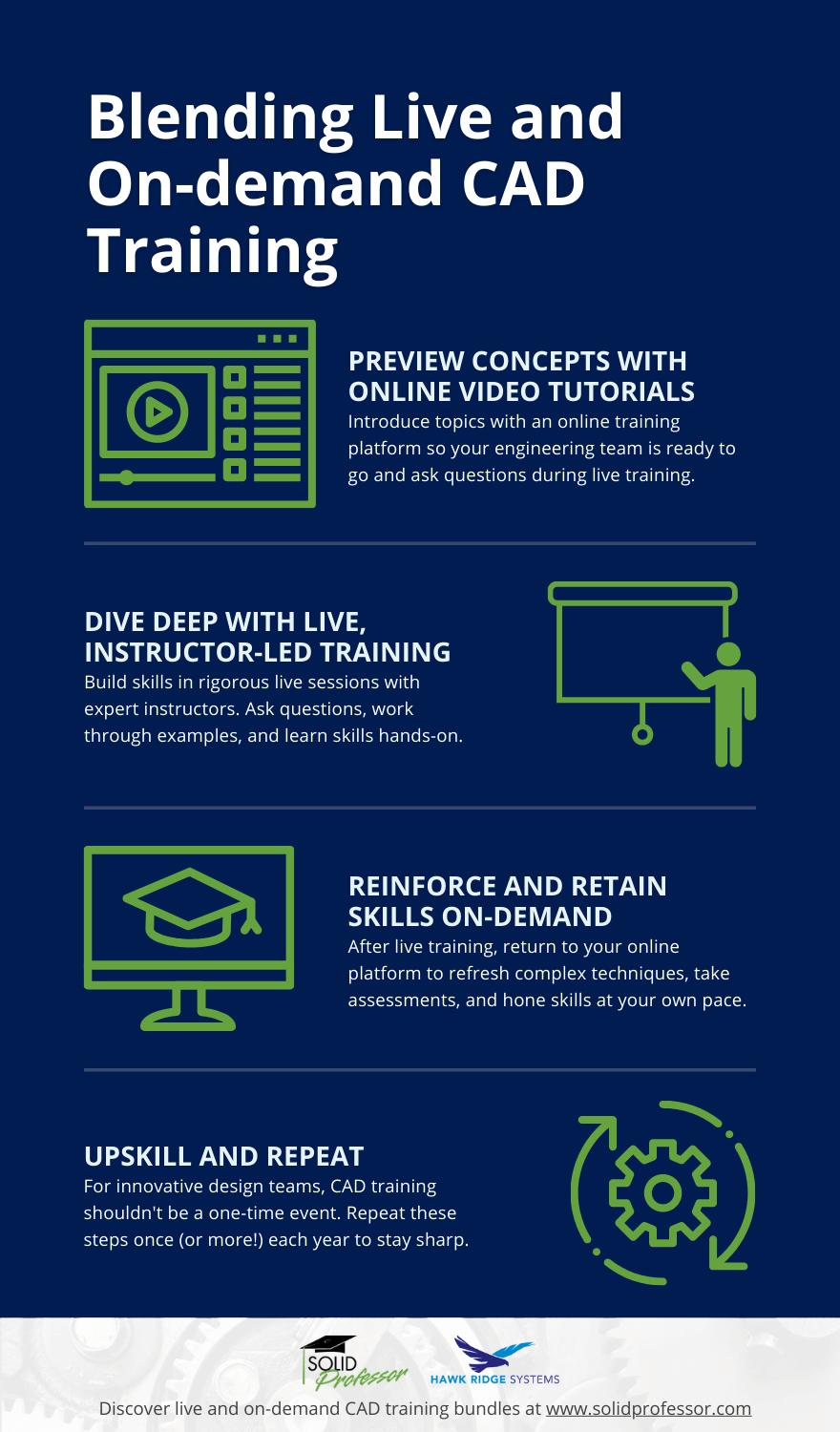Blended SOLIDWORKS Training? It Could be the Skill Boost Your Design Team Needs
SOLIDWORKS training with a live instructor, or online SOLIDWORKS tutorials… Why not both?
In the academic world, blended learning has become widely popular for instructors and students, especially in STEM education. In basic terms, blended learning is an approach that combines online learning with instructor-led class time: two effective methods that are stronger together than individually. It’s an effective way to adapt traditional teaching methods to integrate modern technology and allow for more opportunities to learn outside of class.
But why should this matter to professional engineering design teams?
If you think about it, professional CAD training, much like academia, has two effective learning models. Traditionally, many engineering teams have relied on live training sessions offered by their software reseller to learn SOLIDWORKS. But these days, online, on-demand SOLIDWORKS training options for design teams exist as well. Both methods have their unique benefits for learning CAD.
Traditional Instructor-led SOLIDWORKS Training is Fundamental.
Live SOLIDWORKS training courses are a long-time staple for CAD users. They provide a tried-and-true way of building strong software skills thanks to:
- Dedicated time spent training (scheduled blocks of hours over several days).
- Rigorous agendas that keep learning on track.
- Guidance from a live, expert instructor.
- Opportunities to ask questions in real-time.
Online Learning Platforms Help Keep SOLIDWORKS Skills Sharp.
Online SOLIDWORKS training is becoming more essential than ever with the rapid digitization of engineering design. It offers key benefits of its own:
- Ability to learn anytime, anywhere and at your own pace.
- Flexibility to train a few minutes at a time instead of large time blocks.
- Tools for progress tracking, testing, and skills gap assessment.
- Costs a fraction of traditional CAD training.
Both Methods Are Good on Their Own, But Better and More Effective Together.
Both training methods have their advantages; however, it’s their disadvantages that highlight where a blended approach would be more effective.
Live training can be tough to budget for in both dollars and time. Many CAD departments can only afford a few in-person trainings per year, if that. And since live training doesn’t happen regularly for many businesses, retaining knowledge from an all-day session is a common challenge. According to the forgetting curve, you only retain 40% of what you learned just two weeks after training. That lack of knowledge retention could be why 40-60% of SOLIDWORKS technical support calls are basic, how-to questions.
The availability of online training helps designers retain skills throughout the year. However, while you can build structured training programs in an online platform, when it comes to a true deep dive on a topic, traditional live training will offer the most focused approach. Live training also presents the opportunity to ask instructors questions in real-time, which isn’t always available with online training. Many design teams also find it difficult to set aside time for online training when it isn’t scheduled on their calendar like a live session.
How to Effectively Blend Live and On-Demand SOLIDWORKS Training
The shortcomings of each method provide the perfect reasons to take a blended approach. For design teams searching for the best way to upskill in SOLIDWORKS, it makes sense to combine both live and on-demand training.
Blending the two CAD training methods results in an upskilling plan that’s greater than the sum of its parts, because what one method lacks the other method provides. Here’s how we recommend getting started with live and on-demand SOLIDWORKS training:

- Establish a baseline and introduce topics with on-demand SOLIDWORKS tutorials. With an online learning platform, you can prepare for your live training by assigning short SOLIDWORKS tutorials for your team to watch beforehand. That way, they’ll be ready to ask the instructor questions. You can even assign a baseline assessment to gauge where your team’s skill level is at before they head into live training for a more tailored session.
- Dive deep into the material and engage with live, instructor-led sessions. Many live SOLIDWORKS courses will run for several hours each day for about a week. This offers plenty of time for engineers to learn new SOLIDWORKS techniques, practice applying them, and work with the instructor to answer questions and solve problems.
- Measure progress, reinforce knowledge, and stay sharp with online training. Returning to online training after a live session is effective in several ways. Access to on-demand SOLIDWORKS training can help mitigate skill decay by allowing you to refresh important skills and reinforce more complex concepts on your own time. Plus, a few weeks after your live training sessions is the perfect time to have your team complete a review test to gauge their progress. Compare to your initial baseline test scores for the most transparent view of the training’s effectiveness.
Interested in setting up your engineering team with blended SOLIDWORKS training? Explore live and on-demand SOLIDWORKS training bundles from SolidProfessor and Hawk Ridge Systems.
























